1. To understand how to improve flexibility, first you need to be able to define it. Flexibility is the ability to move a joint through its complete range of motion without pain or stiffness. An example would be being able to reach your toes when you bend down.
2. Everyone has their own natural range of motion. Some people are just biologically more flexible than others, and that’s fine. Some muscles are tighter than others, which impacts flexibility. Trying to push your joints further than they are built to go can cause damage. There are, however, ways you can lengthen the muscles to make your movements looser.
3. The main way to improve your flexibility is through stretching. This may be in flexibility-focused exercises like yoga or tai chi, or as part of the warmup or cooldown for a more cardiovascular workout. Incorporating stretching is an important part of any exercise routine.
4. Stretching is important, but so is stretching safely. Never stretch cold muscles, and stop if it becomes painful.
5. Some people are hyperflexible. They are bendier than other people and may not need to do the same kind of flexibility training. Instead, they may have to focus on resistance training to try to strengthen and stabilize their joints.
6. People who have good flexibility are less likely to injure themselves in any type of exercise and will have better overall performance.
7. If you are trying to do more stretching, you need to recognize that there are different types of stretches you can do. Understanding static and dynamic stretches and their different purposes is an important part of making your stretching routine more effective.
8. Static stretches involve holding a controlled position. Dynamic stretches involve movement (like lunges). The first is better for a cooldown, when you’re trying to bring your muscles back to normal and reduce injury risk. The second is good for warming up as it’s more active and helps get the blood flowing.
9. You are likely to become less flexible as a natural part of growing older. Flexibility training can reduce the impact of aging, but it might not stop it completely.
10. Any balanced and effective exercise regimen should include flexibility training as well as strength and cardiovascular work. It’s an important part of achieving the best overall health.




